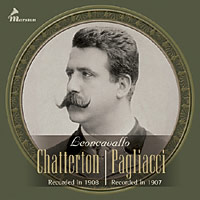A Note from Ward Marston
Leoncavallo’s Chatterton and Pagliacci
The two operas presented here are among the first complete operas ever recorded. Considering the limitations of the acoustical recording process, the sound of these recordings is truly spectacular. What is more, one can really feel a sense of listening to an integral performance. This is primarily due to the fact that the orchestra sounds so natural. Much of the singing is also well-recorded and the total effect is amazingly satisfying. Transferring these discs was not an easy job, however, and I feel I ought to mention some of the challenges that I encountered along the way.
The Pagliacci was originally issued on twenty-one single-sided discs, comprising seventeen twelve-inch and four ten-inch sides. It was apparently issued as a set in its own album with a brochure, although I have never known one to have surfaced. Since the complete edition would have been quite costly, buyers would have been able to purchase each disc separately. That is why the Prologue, for example, is quite common, whereas other discs such as the orchestral intermezzo are almost never seen. Later on, some of the sides from this recording were offered as double-faced discs but as far as I am aware, the solo discs by Antonio Paoli were only issued single-faced. When this recording was issued in America by the Victor Talking Machine Company, six sides were omitted: nine, ten, thirteen, fourteen, fifteen, and eighteen. Since the Victor pressings tend to be quieter than their HMV counterparts, I have used mint condition Victors whenever possible. The sides that were only issued by HMV are quite scarce but fortunately, I was able to locate excellent copies of these discs. The sound on this set is extremely well balanced with the voices perfectly focused. The major flaw in the recording is the severe pitch instability that afflicts many of the sides. In order to keep the pitch constant, it was necessary to decrease the speed by several RPM during the transfer of each side. There were also some sudden lurches in pitch that I have tried to correct.
The Chatterton recording, made a year later, posed different problems than Pagliacci. The sound of the orchestra is possibly the best I have ever heard on an acoustic recording, although the playing itself is terrifically unrehearsed. The orchestration sounds quite realistic except for some harp passages that are obviously played on an upright piano placed far from the recording horn. When I began to remaster these discs, I was immediately relieved to hear that the pitch throughout the recording was quite constant. I was, however, dismayed to find that the overall sound level was considerably lower than in the Pagliacci recording which makes the background noise more prominent. By carefully choosing the proper stylus to play each side and with subtle changes in equalization, I have been able to reduce the noise to some extent. I have not employed any invasive computer-based noise reduction software which can adversely affect the sound of the recording. The singers are all clearly recorded with the exception of the tenor Francisco Granados who is, on most sides, placed so far from the recording horn as to make him almost inaudible. Perhaps this was a conscious decision either by the composer or the recording engineer since he is obviously the weakest member of the cast. In this instance, I decided not to tamper with the original sound and have therefore left Granados in the background. The only other serious problem with the recording can be heard on matrix 1473c (CD 1, Track 24.) Toward the close of the side, the sound deteriorates drastically, most likely due to a malfunction of the recording apparatus. I have only ever seen two copies of this disc and both contain the same sonic flaw.
Since no publicity documentation exists for the Chatterton recording, it seems doubtful that it was ever offered as a complete set. Given the extreme rarity of the Chatterton discs, we can assume that only a small number of each disc was pressed and even fewer were ever sold. Fortunately, at least one copy of each disc still exists so that we can hear the opera in its entirety conducted by none other than its composer. Concerning the question of whether Leoncavallo actually conducted the Pagliacci recording or merely supervised the sessions, we will probably never know the answer. In either case, this recording, replete with marvelous singing by the entire cast must be clearly viewed as the authentic version of Leoncavallo’s most popular opera.

Leoncavallo’s Chatterton and Pagliacci
In 1907, the G&T Company issued Leoncavallo's Pagliacci. The cast included Giuseppina Huguet, Antonio Paoli, Francesco Cigada, Ernesto Badini, and La Scala's orchestra. It had been assumed that Carlo Sabajno conducted this ensemble with Leoncavallo present during the recording sessions. However, recently uncovered contract-correspondence leads one to believe that Leoncavallo was the conductor making this recording possibly the most authentic Pagliacci on record. At the time of its release, this recording was so successful that G&T once again hired Leoncavallo to conduct another of his operas. Chatterton, a Leoncavallo opera that is barely a footnote in many opera books, was released the following year. Chatterton, featuring Francesco Signorini, Francesco Cigada, Ines de Frate, and Annita Santoro provides the listener a glimpse of a rarely performed opera by a well-known composer.